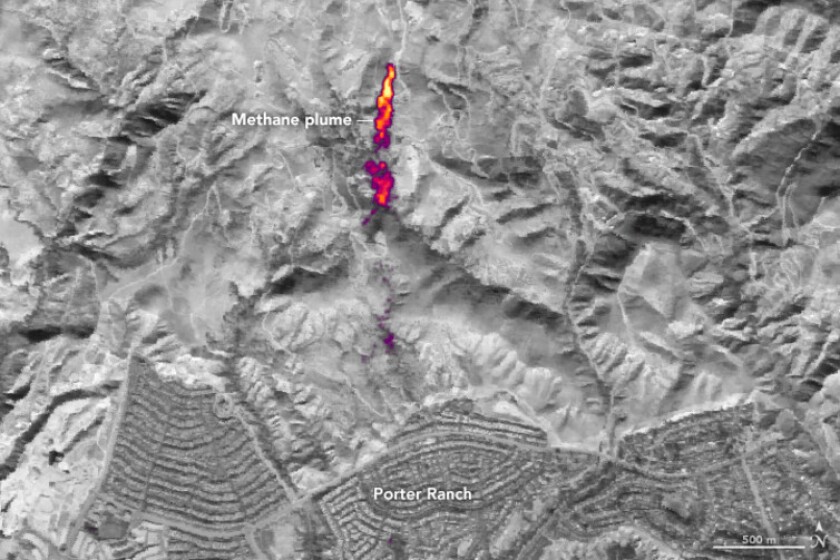Methane is the major component of natural gas, which heats our homes and recently surpassed coal as the top fuel for generating electricity in the United States. But methane is also a powerful greenhouse gas that contributes to global warming. And because methane is highly flammable, gas leaks pose a significant safety hazard, as we saw in fatal explosions in 2010 in San Bruno, California and 2015 in New York City. The massive gas leak from the Aliso Canyon storage facility in Southern California in October 2015 led to evacuations of over 8,000 families after reports of serious health issues.
The United States, Canada and Mexico are working together to reduce methane emissions from the oil and gas sector through the North American Climate, Clean Energy and Environment Partnership. As one step, the U.S. Environmental Protection Agency (EPA) recently finalized rules that require oil and gas companies to adopt leak detection and repair programs.
EPA recommends that gas companies use infrared cameras, one of the most commonly available leak detection technologies. These cameras enable gas leaks to be detected rapidly and safely. Although other detection technologies are available, they’re either expensive, slow or unsuitable.
My research focuses on evaluating leak detection technologies and using those insights to inform emissions mitigation policy. In our most recent work, we analyzed the limits of infrared cameras in effectively detecting methane leaks. Some of these limitations have important policy implications.
Cameras work better in some conditions than others
Infrared cameras work much like an iPhone camera, with a key difference. While an iPhone camera is sensitive to visible light, infrared cameras are sensitive to infrared light, the portion of the sun’s light that is invisible to the naked eye and has wavelengths longer than red. Since methane is sensitive to infrared light, infrared cameras can detect it. Indeed many production facility operators use them routinely for leak detection and repair procedures, with anecdotal success.Despite such evidence, there were no systematic studies on the effectiveness of these cameras. And because all objects emit infrared light, we suspected that environmental conditions might play an important role in how the camera works. In the study I coauthored, we analyzed how environmental factors like temperature, wind, humidity and background conditions affected what the camera “sees.”
We developed a model to predict whether the camera will detect a leak of given size under different measurement conditions. In order to verify that this model is accurate, we intentionally released methane and compared the corresponding camera images with model results.
We found that the cameras’ effectiveness in detecting leaks was highly variable based on weather conditions. Also, the camera operator’s expertise and even properties of the facility, such as its location and gas composition, affected the readings. Under ideal conditions, the cameras detected over 80 percent of the total leakage at the facility.
But such a high success rate is possible if and only if the camera is operated during periods of low wind, warm weather, clear skies and leaks are imaged from distances of about 30 feet. Under nonideal conditions (high wind, cold days or viewing distance greater than 100 feet), they detected as little as 10 percent of the total leakage.
Recent EPA regulations do not specify many crucial parameters. For example, an operator decides maximum viewing distance and acceptable wind conditions for testing leaks; and there are no requirements on temperature or cloud cover conditions.
With such latitude in determining testing protocols, an operator can perform a leak detection survey, without actually finding any leaks. This can be done by searching for leaks on cold or humid days or measuring from distances farther than about 100 feet. In order to consistently find leaks using this technology, we concluded that EPA’s rules need to be more specific, or use a different metric to track progress.
A possible solution: Fix ‘super-emitters’
“Super-emitters,” as the name implies, are very large leaks with a leak rate between 100 tons/year to over 1,000 tons/year. All tests that have been conducted at gas facilities – production wells, processing facilities and compressor stations – often find a small number of these super-emitters.Infrared cameras are naturally suited to detect these super-emitters because it is easier to detect bigger leaks than smaller ones, even under unfavorable measurement conditions. Fixing super-emitters could be a cost-effective way for facility operators to significantly reduce leakage and improve safety.

Not all locations are created equal
The number and sizes of leaks at any facility vary significantly across the country. For example, recent research at production facilities has shown that super-emitters contribute to a larger fraction of total leakage in Pennsylvania compared to Texas. Because super-emitters are easily detected by these cameras, leak detection will be more effective in Pennsylvania than in Texas.In addition to its size, the composition of a leak can also significantly affect detection. Drilled wells can often release nonmethane gases like ethane and propane. Often termed “wet-gas,” these nonmethane compounds are more sensitive to infrared light than methane. Therefore, a leak rich in these compounds will “look” brighter than a similar leak that contains only methane. Such situations commonly occur in regions where significant oil is also extracted along with gas.
These subtleties have important consequences for policy. A camera’s effectiveness depends not only on its own properties, but also on the properties of the facility being tested. An 80 percent success rate in one location will not translate into a similar success rate at other locations.
Better options?
Detecting methane leaks is a hard problem further complicated by the large number of potential sources and by a scarcity of cheap detection technologies. By effectively endorsing infrared cameras as a preferred option, EPA has rightly chosen the most efficient and, by some estimates, least-cost option.However, new technologies and startups, many funded by the Department of Energy’s MONITOR program, are being developed. Although many are in their early stages, these new technologies promise faster and more accurate leak detection. It would be a mistake for any mitigation policy to not take advantage of these new technologies, especially if they can further reduce costs and improve safety. We are currently researching broader questions on ways to design effective methane mitigation policy. How this will unfold in the context of the incoming administration remains to be seen.

Arvind P. Ravikumar, Post-doctoral Fellow: Energy systems analysis and energy policy, Stanford University
This article was originally published on The Conversation. Read the original article.






